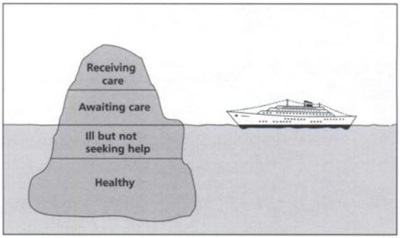Introduction
 Learning objectives: You will learn about the measures available, including self-reported health and more recent developments.
Learning objectives: You will learn about the measures available, including self-reported health and more recent developments.
Measuring health status is confounded by a number of factors, and this section outlines the data available and potential future developments.
Read the resource text below which covers measuring health status.
Resource text
Self reported health is by its nature subjective, and different people will have different thresholds for what is considered 'serious' or 'very painful'. Definitions can change over time as well. Conversely, people can forget illnesses that they have had, or choose to withhold information. However, only a proportion of people experiencing ill-health make contact with health services. Self reported ill-health can therefore help to show more of the burden of ill health in the population that is otherwise under the line.
Figure 1: The iceberg concept

Source: Donaldson and Donaldson 'Essential Public Health' 2nd edition.
Data on self reported health status can be accessed through three main sources, including the census, the Health Survey for England and the General Household Survey.
The Health Survey for England includes a question on self reported general health and long term limiting illness. Further detail which may be available through the Health Survey for England, a series of annual national surveys about the health and related behaviours of people in England involving about 16,000 adults. This has been carried out since 1991 and it combines a questionnaire with taking some physical measurements and blood samples. Questions on specific diseases, such as cardio-vascular disease and accidents, are also asked at certain intervals . However, at present its sample size is not large enough to provide PCT/local authority level data. It is open to concerned organisations to sponsor a boost of the Health Survey for England. Therefore, there may be geographical variation on the areas covered by the survey for the analysis of PCT level data.
The General Household Survey is conducted every year and involves approximately 13,000 adults in Great Britain. It provides information on all sorts of areas for government departments. On health issues, questions include acute illness in the last 2 weeks, illness over the last year, presence of chronic illness, consultations with a doctor, visits to hospital, and smoking and alcohol consumption. The General Household Survey has indicated an increase in self-reported long-standing illness.
More recently, there has been an interest in measuring population health as part of evaluating health outcomes following an intervention. There are a number of instruments which may be used for this purpose. The main benefit of using these types of questionnaires is that they provide a more accurate measure of health as compared with self-reported measures, and the outcome can be compared with the expected values for the general population. Examples of questionnaires available are the EQ5D, SF-36 (with a short form SF-16), PDQ39 (with a short form PDQ8). This is a self-completion questionnaire, which may be used for specific studies or evaluation projects. Studies in Europe using the EQ-5D can be registered through http://www.euroqol.org/ where further support is available.
References
Donaldson LJ, Donaldson RJ (2003) Essential Public Health 2nd Ed. Radcliffe Publishing Ltd
Related links
http://www.statistics.gov.uk/ssd/surveys/general_household_survey.asp
